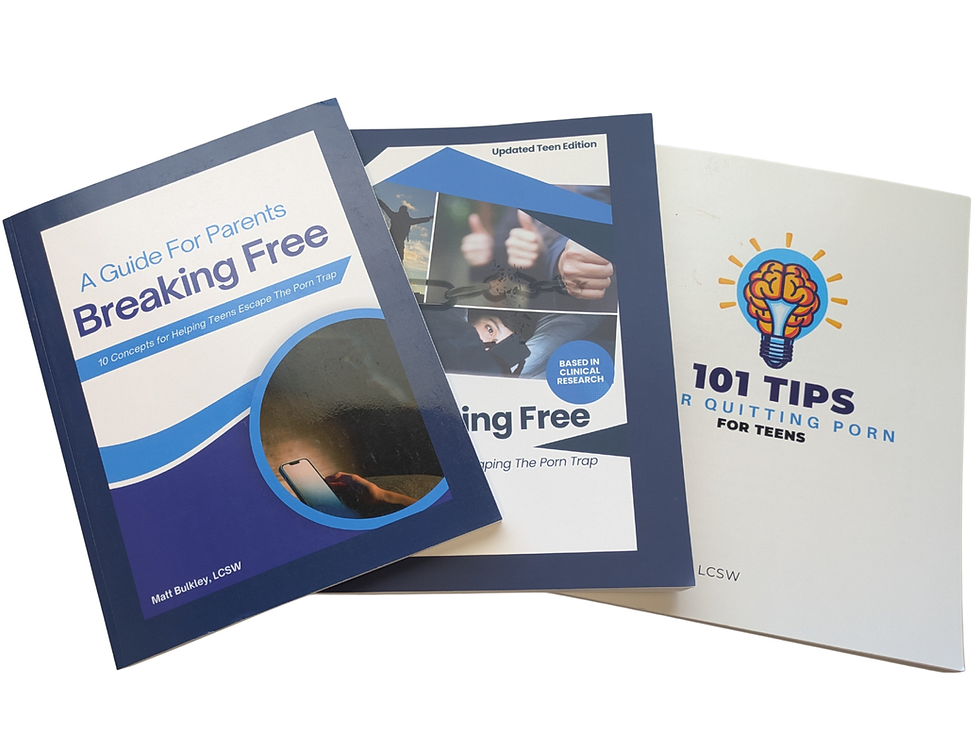Helping Your Teen Overcome Pornography Addiction: The Power of Real Relationships
- Matt Bulkley

- Jul 11
- 4 min read
As parents, watching your teen struggle with pornography addiction can feel overwhelming and disheartening. You may wonder how to guide them toward healthier habits and stronger emotional connections. The key lies in understanding how pornography affects the brain—specifically through a hormone called oxytocin, often nicknamed the “bonding brew”—and why fostering real, meaningful relationships is critical to their recovery. By prioritizing authentic human connection over virtual stimuli, you can help your teen rebuild healthy emotional patterns and rediscover the rewards of genuine intimacy.
What Is Oxytocin, and Why Does It Matter?
Oxytocin is a hormone and neurotransmitter that plays a vital role in building trust, closeness, and intimacy in relationships. It’s released during moments of connection, like hugging, sharing a heartfelt conversation, or spending quality time with loved ones. These interactions create feelings of safety and emotional warmth, strengthening bonds with family, friends, and partners. For teens, whose brains are still developing, oxytocin is essential for learning how to form healthy, lasting relationships.However, pornography can disrupt this natural process. When a teen engages with pornography, their brain mimics an intimate experience, releasing oxytocin in response to the images or videos on-screen. Unlike real relationships, these digital interactions lack mutual care, trust, or emotional investment. Over time, the brain begins to associate oxytocin’s “feel-good” bonding effects with artificial stimuli rather than real people, making genuine connections feel less rewarding. This rewiring can trap teens in a cycle where pornography becomes a substitute for authentic intimacy, leaving them emotionally isolated and disconnected.
How Pornography Hijacks the Brain’s Bonding System
Pornography’s impact on oxytocin creates several challenges for teens:
Diminished Real-Life Intimacy: Chronic pornography use can desensitize the brain to the subtle cues of real-world connection, like physical touch or eye contact with a loved one. A 2021 study in the Journal of Sexual Research found that heavy pornography use is linked to lower relationship satisfaction, partly because the brain becomes less responsive to the oxytocin released during authentic interactions. For teens, this can make friendships, family bonds, or romantic relationships feel less fulfilling, leading to emotional distance.
A Shortcut to False Intimacy: Pornography offers a quick, effortless “hit” of oxytocin without the vulnerability or effort required in real relationships. This instant gratification can create a feedback loop, where teens turn to pornography to simulate closeness rather than navigating the complexities of human connection. Over time, this reliance can weaken their social skills and emotional resilience, contributing to feelings of loneliness or even depression.
A Disruptive Mix of Brain Chemicals: Pornography triggers both oxytocin (bonding) and dopamine (reward-seeking), making it feel uniquely compelling. It mimics the excitement and emotional connection of real intimacy but lacks the mutual trust and care that make relationships truly fulfilling. This leaves teens chasing an artificial version of closeness that can’t satisfy their deeper emotional needs.
Why Real Relationships Are the Key to Recovery
To help your teen break free from pornography addiction, it’s essential to guide them toward rebuilding their brain’s natural oxytocin responses through real, meaningful relationships. Unlike the fleeting, one-sided “connection” of pornography, authentic relationships offer reciprocal trust, mutual care, and lasting emotional rewards. Here are practical steps you can take as a parent to support your teen:
Encourage Meaningful Connection: Foster opportunities for your teen to engage in bonding activities that naturally release oxytocin. Family game nights, shared meals, or heartfelt conversations can strengthen emotional ties. Encourage participation in group activities, like sports, clubs, or volunteering, where they can build friendships and practice social skills.
Promote Physical Touch: Non-sexual physical touch, like hugs or a pat on the back, is a powerful way to boost oxytocin and reinforce family bonds. Simple gestures can remind your teen of the comfort and safety of real human connection, counteracting the artificial pull of pornography.
Model Open Communication: Create a safe, non-judgmental space for your teen to share their feelings and struggles. Deep conversations—where you listen actively and show empathy—can trigger oxytocin release and help your teen feel understood and valued. Avoid shaming them about their pornography use, as this can push them toward emotional avoidance.
Set Healthy Boundaries Around Technology: Work with your teen to reduce screen time and limit access to triggering content. Encourage activities that don’t involve devices, like outdoor adventures or creative hobbies, to help their brain recalibrate toward real-world experiences.
Seek Professional Support: If your teen’s pornography use feels overwhelming, consider consulting a counselor or therapist who specializes in addiction or adolescent mental health. Therapy can help your teen address underlying emotional needs and develop strategies to prioritize real relationships.
The Path Forward: Rebuilding Connection
Pornography addiction can make real relationships feel less rewarding for your teen, but recovery is possible. By reducing their reliance on artificial stimuli and fostering authentic human connections, you can help them rewire their brain to associate oxytocin with the people who matter most. This process takes time, patience, and intentional effort, but the rewards—stronger family bonds, healthier friendships, and emotional resilience—are worth it.As a parent, your support and understanding are powerful tools. By emphasizing the value of real relationships and creating opportunities for meaningful connection, you can guide your teen toward a life filled with genuine intimacy and emotional fulfillment. Together, you can help them rediscover the beauty of authentic human bonds—one hug, conversation, or shared moment at a time.
Resources for Parents:
For more information on supporting your teen, explore resources on our website.










Comments